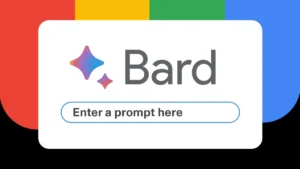Unlocking Conversational Intelligence: Google’s Bard AI Mastery
In the realm of AI chatbot tools, Google Bard Ai emerges as a formidable force, seamlessly blending advanced natural language processing and machine learning to replicate human-like conversations. Developed by Google, Bard elevates the search experience by introducing a more natural language interface for queries and responses.
Power of Gemini: Fueling Bard’s Linguistic Prowess:
At the core of Bard’s capabilities is the Gemini large language model, succeeding predecessors like PaLM 2 and LaMDA. This model taps into the transformative potential of Google’s renowned Transformer architecture, initially unveiled in 2017. This architecture has not only shaped Bard but also paved the way for other influential AI tools, including the widely acclaimed GPT-3 featured in ChatGPT.
2. Conversational Brilliance: Bard’s Unique Offering
Bard sets itself apart with its exceptional conversational prowess, delivering responses enriched with context and seamlessly accommodating follow-up questions. Crafted for effortless integration into websites and applications, Bard Ai goes beyond typical chatbot capabilities by accessing information from various Google services, enhancing its utility for users.
3. Global Unveiling: Bard’s Journey to Accessibility
The global introduction of Google’s Bard Ai unfolded on March 21, 2023, inviting users to join a waitlist and experience its capabilities. The waitlist phase concluded on May 10, 2023, propelling Bard’s availability to over 180 countries. This marked a significant stride in expanding its accessibility on a global scale.
4. Navigating Challenges: Bard’s Early Scrutiny
Despite its promising features, Bard faced scrutiny during a live demo, where an erroneous response triggered a decline in Google’s market value. However, this setback does not diminish Bard’s potential, as it integrates advanced models like PaLM and Gemini to enhance reasoning, planning, and overall understanding.
5. Universality in Utility: Bard’s Global Reach
Available to users aged 18 and above with a personal Google account, Bard Ai spans across more than 230 countries, supporting over 40 languages. This widespread accessibility positions Bard as a powerful addition to Google’s suite of services. Notably, at present, Bard is not associated with any charges, aligning with Google’s commitment to providing free services.
In summary, Google Bard emerges as a revolutionary AI chatbot, seamlessly blending cutting-edge technology with a commitment to global accessibility. Its journey, marked by innovation and adaptability, positions Bard Ai as a significant player in the evolving landscape of conversational AI.
Battle of the Chatbots: Google’s Bard Ai vs. ChatGPT
1. Common Ground: AI Chatbot Basics
Both Google’s Bard Ai and OpenAI’s ChatGPT are leading AI chatbots designed for human interaction, employing natural language models and machine learning. Central to their functionality is the use of a large language model (LLM), a crucial component for generating conversational text.
2. Generative AI in Action
ChatGPT showcases its prowess in generative AI, allowing it to create original content upon user requests, such as writing a thesis on the advantages of AI. Google Bard, while sharing generative capabilities, is tailored to enhance the naturalness and helpfulness of search interactions, synthesizing new information to enrich its responses.
3. Search Engine Integration
ChatGPT takes a significant step in the search domain, with Microsoft integrating it into its Bing search engine for conversational search results. Google Bard, on the other hand, is exclusive to Google’s platform, limiting its integration to Google services.
4. Temporal Distinction: Data Up-to-date vs. Cut-off
A notable difference lies in the temporal relevance of the data. ChatGPT relies on information available up to April 2023, potentially posing a challenge in providing up-to-date answers. In contrast, Google Bard leverages current data, ensuring its responses align with the latest information.
5. **Plagiarism Detection
OpenAI addresses concerns about plagiarism with ChatGPT, offering a detection tool for educators. Google Bard, while citing sources in responses and featuring a double-check function, doesn’t explicitly mention a dedicated plagiarism detection tool.
Alternatives to Google Bard
Explore other AI chatbot contenders in the arena, including:
Microsoft Bing: Teaming up with OpenAI, Microsoft Bing aims to offer a similar AI-powered search experience.
ChatSonic: Marketed as a ChatGPT alternative, ChatSonic combines AI-based text generation with real-time topic discussion.
Jasper Chat: Tailored for copywriting, Jasper Chat focuses on generating brand-relevant content and facilitating customer conversations.
YouChat: Hailing from the You.com search engine, YouChat not only provides answers but also offers citations for fact-checking.
NeevaAI: Another offering from a German search engine company, NeevaAI summarizes multiple sources and provides citations to enhance answer reliability.
In the evolving landscape of AI chatbots, these alternatives present diverse features and capabilities to cater to various user needs.
Latest Post: Unleashing,” emphasizing the transformative impact of Bard Ai on the search landscape.

Thanks for sharing. I read many of your blog posts, cool, your blog is very good.